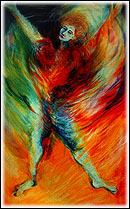- » Home
- » Groups and Workshops
- » Authentic Movement
Authentic Movement with Theresa
 What is Authentic Movement?
What is Authentic Movement?
Authentic Movement is a subtle yet powerful process that serves as a form of body/mind therapy, as a vehicle for opening to one's creative self, and as a spiritual practice. The form itself is deceptively simple to describe. It consists of one or more persons moving spontaneously with their eyes closed in the presence of one or more persons witnessing.
The safe, supportive "container" formed by being witnessed as one is, without analysis or judgment, creates an accepting space for the mover's true self to emerge. Health professionals, artists, counselors, educators, and those interested in personal and spiritual growth find freedom of expression while stimulating creativity, healing wounds, and learning to trust the body's wisdom.
Authentic Movement was developed and named in the 50's by Mary Starks-Whitehouse, Jungian analyst and dance therapist, and is continually in the process of being developed and articulated. Although there are variations, the basic form is constant and provides the foundation for this powerful practice.
"Useful therapeutically, meditatively, or within any creative process, the discipline of Authentic Movement is defined by the relationship between a person moving and a person witnessing that movement. Inherent in being a person in the cultures of the West is the deep longing to be seen as we are by another. We want to be witnessed, without judgement, projection or interpretation. Ultimately, we want to witness, to see another."
- Janet Adler
The mover, with eyes closed, turns her attention inward and focuses on internal impulses, sensations, feelings and images as they emerge. She allows these to be expressed freely through natural intrinsic body movement, breath, and sound. There is no right way, no wrong way to do Authentic Movement; there is only each person's unique way. It can be a purely kinesthetic experience, simply stretching and moving the body through space; it can be an emotionally-laden, even cathartic experience, as some image or old memory is activated; it can be a transcendent experience that allows the mover to feel a part of something larger; in other words, it can be whatever emerges in the moment.
By following our moment-by-moment cellular promptings, we develop an entryway into a direct experience of our core of being, and open to a palpable experience of a greater presence beyond ourselves. In this form of active meditation, we drop preconceived ideas and patterns of thinking and moving in order to receive and express simultaneously what each moment brings.
The practice of the witness is to develop a meditative, compassionate presence that provides the mover with a sense of safety and unconditional acceptance. The witness sits with a profoundly receptive attitude and attempts to "see clearly," without judgment, analysis, interpretation, or projection. She also pays great attention to her own sensations, feelings, images, and stories, in order to distinguish between who she is and who the mover is. In a sense, the witness task is more demanding; since she is witnessing both the mover and her own internal process. She learns to recognize and drop habitual barriers of thought and projection that keep her from seeing others clearly, as they are.
The Mover-Witness Relationship
The form of Authentic Movement employs various constellations of the mover/witness relationship: the teacher witnessing the whole group moving, dyads, triads, half the group moving/half witnessing, or, even at times, one mover being witnessed by a group of witnesses. After a movement sequence, there is frequently a time for drawing, writing, clay work, or self-reflection, to allow each person to integrate whatever material has emerged and to further connect themselves to their creative, symbolic, spiritual lives. Only then do mover and witness sit together to speak, if they choose, of their experiences. The mover always speaks first and her desire to hear-or not hear-from the witness is respected. The verbal component of witnessing is another source of conscious practice, as the witness clearly and consciously distinguishes between what she actually saw/perceived and any responses that were evoked in her by the movement.
